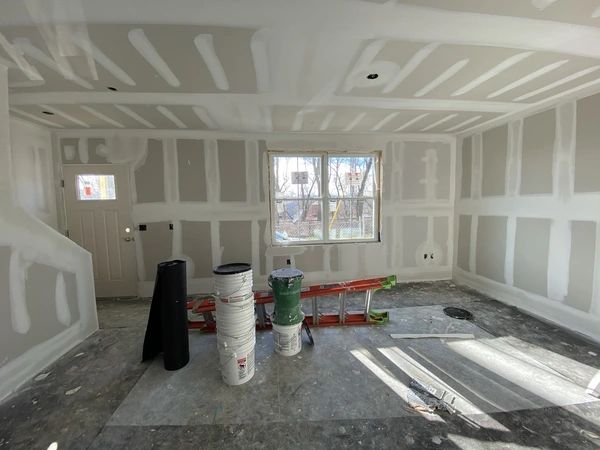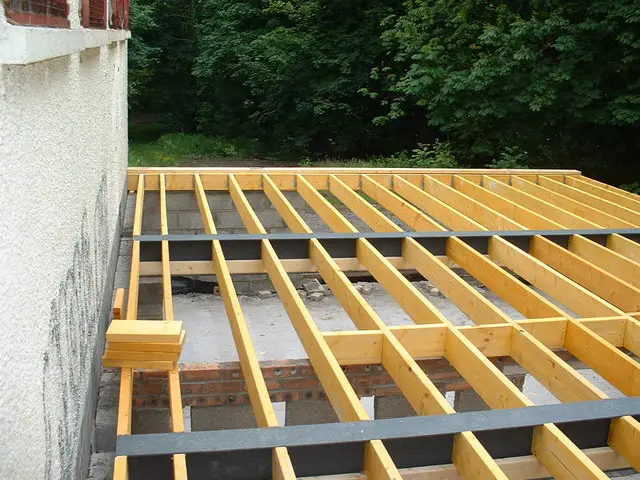Whether you’re waiting to sand or getting ready to paint, waiting the appropriate amount of time for drywall mud (aka joint compound) to dry is essential to getting the best results.
Drywall Mud and Joint Compound Overview
Drywall “mud”, “joint compound”, “joint cement”, and “drywall compound” are interchangeable terms for the cake-frosting-like mixture used in taping and patching sheets of drywall. This mixture is typically made from ground limestone, gypsum, clay, perlite, polymers, and water and hardens as it dries. When completely dry, joint compound can be easily sanded and shaped to create a smooth, virtually invisible transition between drywall panels or to add texture to a wall. The application of mud creates a wall surface that is completely consistent in appearance and texture.
The drying time for drywall mud varies depending on the type used, application thickness, humidity, and temperature. However, in general, a thin, single coat of drywall mud should be allowed to dry overnight, or at least 12 hours, before sanding, adding another coat, and/or painting.
Different Types of Mud
Drywall mud comes in a variety of types and is available either pre-mixed in buckets or powdered and sold in bags or boxes. Most mixture types have specific uses and methods for application that professionals in the construction industry are cognizant of, while other types of joint compound can act as somewhat of a catch-all for DIYers or are otherwise used for quick, less finicky jobs. We’ll discuss the various types of mud and the differences between them in detail, below:
“Conventional-Weight” or “Heavy” All-Purpose Joint Compound
Conventional-weight all-purpose joint compound can be readily found in most big-box home improvement stores and neighborhood hardware stores in the US. This type of mud is considered the jack of all trades in the drywall world and can be used at all stages of the process: to tape and fill drywall joints; to skim-coat; to add texture to wall surfaces; and to apply a top or finish coat, though it does better at some of these stages than others.
Conventional-weight all-purpose mud is very sticky and forms a strong bond, but it does experience a fair amount of shrinkage and cracking as it dries, and it is more difficult to sand than other mud options. This means that more coats and more sanding are typically needed for a quality end result which makes all-purpose joint compound less appealing to those applying finish coats or filling larger seams, gaps, or holes. Most mixtures of all-purpose joint compounds instruct the user to, at minimum, allow each coat to dry overnight before adding an additional coat, sanding, priming, or painting.
Lightweight and Ultra Lightweight All-Purpose Joint Compound
Lightweight all-purpose mud is much less common in the US than conventional-weight mud and is fairly self-explanatory. It is only about 50%-75% the weight of its conventional-weight counterpart which allows for much less shrinkage and easier sanding, making it a better choice for finishing than heavier mud. Furthermore, because lightweight all-purpose mud contains a higher percentage of adhesives, it is also a better choice for taping than conventional-weight all-purpose mud, though it will not perform as well as taping mud. The purpose of lightweight all-purpose joint compound is to take the place of both a taping compound and a topping compound rather than needing both, and it is one of the best options available for coating steel beads.
Much like heavier all-purpose joint compound, most brands instruct the user to allow each coat to dry overnight (approximately 12 hours) before adding an additional coat, sanding, priming, or painting. However, lightweight mud generally tends to dry faster than heavier weight mud. One rapid-drying mud brand claims that its product can dry completely in as little as 4 hours.
Quick-Setting Compound or “Hot Mud”
As far as drying time goes, quick-setting compounds offer the fastest drying times which allow for multiple coats and quicker jobs. Some set in 90-minutes, some set within an hour, and some set in as little as 20 minutes, depending on the purpose, brand, and overall ingredients. However, it is important to note that quick “setting” does not equate to quick “drying”. What I mean by that is that you can apply multiple coats within a short amount of time, but you may still have to wait a minimum of 12 hours and up to 4 days (depending on the job and how many coats you apply) for your mud to dry before sanding or painting.
Hot muds such as “concrete fill” or “filling mud” are typically used for filling large voids, skimming out ceilings, floating large areas, and times when you are taping with mesh tape. In other words, hot mud is the best choice for most jobs where you will either be applying multiple coats within a short amount of time or applying a thick coat, like in the case of a deep gap fill, and you want to avoid shrinkage or cracking.
Taping Mud
This type of joint compound is specifically meant for laying paper tape. It contains a high percentage of adhesive, allowing for the very strong hold required for taping. However, this high percentage of adhesive also means that this type of mud does not do well at any other stage of the drywall process and requires finishing or topping mud to be used over the top of it due to the fact that it is very lightweight, shrinks extensively, bubbles, and is difficult to sand.
Topping or Finish Mud
As its name suggests, this type of mud is meant specifically for application as a finishing mud. It is not recommended for any other purpose. Topping mud can be applied very smoothly, it sands easily, and it shrinks minimally. Topping mud is typically used as a second or third coat over taping mud or all-purpose joint compound. Most brands instruct the user to allow each coat to dry overnight before sanding, priming, or painting.
Factors that Affect Drying Time
There are a variety of factors that affect drywall mud drying time. These include:
- Room temperature
- Humidity
- Coat thickness
- Number of coats
- “Weight” and composition of the mud
Optimal Conditions to Dry Joint Compound
The optimal conditions for drying drywall mud consist of a temperature within the range of 65-80 degrees Fahrenheit and a humidity level of 20-40%. A single coat will dry faster than multiple coats, a thinner coat will dry faster than a thicker application, and a lightweight joint compound will dry faster than a conventional-weight joint compound. The drying times for the various types of joint compound vary widely depending on material composition, application technique, and room conditions. Greater humidity will slow drying time, as will colder conditions. If a room is too humid or too cold, the joint compound may not adhere properly and will experience greater cracking or may not set fully.
Tips/Methods for Drying Mud Faster
Reduce Humidity – Reducing the humidity in the room by running a heater or a dehumidifier can help shorten drying time. It may also strengthen the wall’s overall construction. However, if you choose to run a heater, ensure that the temperature of the room does not exceed 90 degrees Fahrenheit, as high temperatures can cause curing and bonding issues in the joint compound as well as structural problems in the drywall panel itself.
Apply Thinner or Fewer Coats – Thicker coats or multiple layers of mud take much longer to dry than thinner coats or where fewer layers of mud are used. Thicker coats are also more prone to cracking than thinner coats, regardless of compound type.
Increase Air Circulation – Increasing air circulation within the room by using fans or creating cross-ventilation by opening windows will wick moisture away from the new mud, allowing it to dry more quickly. However, be careful not to allow the room’s temperature to fall below the optimal range. Too cold of a setting temperature can cause the joint compound to adhere improperly and lengthen drying times which can cause bulging drywall panels.
Use a Heat Gun or Hair Blow Dryer – You can place a heat gun or hair dryer approximately 2-3 feet away from the joint compound you’d like to dry. Ensure that you don’t place either of these tools any closer or you could end up with a fire hazard or toasted mud, neither of which would be the intended outcome.
How Can I Tell if My Joint Compound is Dry?
You can typically tell whether joint compound has dried completely based on its color and texture. When dry, drywall mud is typically a very light off-white or white color and feels smooth and is similar in texture to plaster of paris or hardened clay. If the mud is gray or darker than the surrounding thinner applications of mud, the joint compound is most likely not completely dry.
Additionally, if the joint compound feels moist or creates crumbles or nothing at all as you drag your hand across it, it has not dried fully. A joint compound that has fully dried will produce very fine dust when disturbed. Sanding drywall that has not dried completely will result in unsightly drag marks and divots rather than a smooth surface accompanied by fine dust.


